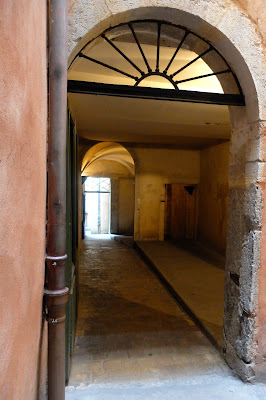With just a few days left in our five-week stay in Lyon,
we’re going down our list of must-do’s before we head for northern France. This past week we checked off a tour through
the famous traboules (passage ways)
in Old Lyon, a visit to a sobering yet inspiring museum, and dinner at one of
Lyon’s iconic bouchon restaurants.
Oh, and finding some walls.
Lyon is the home of CitéCréation, an organization of artists formed in
1978 to beautify cityscapes with enormous murals. Partnering with public institutions and
private companies, CitéCréation (
http://cite-creation.com/eng/) teams have painted some 600 murals in cities
around the world. The largest
concentration of these frescoes is in Lyon, and we’ve had fun tracking them down
in our walks around the city. Most are
vast, covering entire sides of buildings.
A sampling:
 |
| A tribute to the people and culture of Lyon's Croix Rousse district. |
 |
| Croix Rousse mural (detail). |
 |
| Croix Rousse mural (detail). |
 |
| Notable citizens of Lyon through the centuries. |
 |
| Notable Lyonnais (detail). |
 |
| Celebrity chef Paul Bocuse, a son of Lyon (detail). |
 |
| Lyon, a futuristic fantasy. |
 |
| Futuristic fantasy (detail). |
 |
| "Bibliothèque" (library) honoring regional writers. |
 |
| "Bibliothèque" (détail). |
 |
| Tribute to Mexican painter Diego Rivera. |
HIGHLIGHTS OF THE WEEK
Passage
Ways. Vieux Lyon on the right bank
of the Saône, the oldest part of the current city dating back to the Middle
Ages, is known for, among other things, a network of passage ways that connect
various spaces. Some are little more
than tunnels (
traboules) that allowed
movement between parallel medieval streets before the planning of cross-streets
began. In time the term encompassed a
wider variety of architectural features, including courtyards and windowed
stairwells. As wealthy merchants and
financiers built ever more palatial residences in the late Middle Ages and
early Renaissance, traboules became correspondingly more elaborate. We toured the area with an amiable French
guide who was confident enough of his English to toss in wisecracks.
 |
| "Rose Tower" viewed from traboule courtyard. |
 |
| Two views of traboule passage ways. |
 |
| Looking down a traboule spiral staircase. |
A
Museum. In late 1942 Nazi Germany
violated the 1940 surrender agreement that divided France into occupied and
unoccupied (Vichy) zones. German troops
rolled into Lyon, followed by the infamous Gestapo. A German officer, Klaus Barbie (later dubbed
the “Butcher of Lyon”), established the Gestapo HQ in a former French military
hospital, from which he spearheaded counter-attacks against the French
resistance, as well as a reign of terror against Jews and other minority
groups. Today the building houses the
excellent Museum of the Resistance and Deportation. Like other memorials of the Holocaust, the
museum is achingly sad; at the same time, the accounts of heroism by French
Resistance fighters – many of whom were tortured and killed – are stirring. A display recounts the 1987 trial in Lyon of
Klaus Barbie, who, after extradition from Bolivia, was convicted of crimes
against humanity.
 |
| Museum entrance. |
 |
| A symbol of mankind's hopes for the end of war. |
A
Bouchon.
Bouchons started in the 19th
century as rustic eateries
that served hearty, inexpensive meals to workers. The fare is heavy on meat, and hardly any
parts of livestock and fowl go unused.
Somewhere along the line bouchons gained iconic status, and today they
occupy a prominent niche in the self-proclaimed culinary capital of France. This week we sampled bouchon food and
ambience at the recommended Café Comptoir Abel.
Our meals were tasty, and the humming restaurant was made even cozier by
the rain falling outside.
 |
| A daytime photo of our night-time bouchon. |
 |
The Rabelaisian symbol of a "true" bouchon.
|
A Family Meal. The week ended with a rare treat for
foreigners: Sunday dinner with a French family.
A few years back Jim’s brother, John, became friends with a Lyonnais
couple who were in the United States for scholarly research. John informed them of our sojourn here, and
this led to an invitation to dine. Our
hosts, Jérôme and Laure, live in a northern suburb of Lyon with their
12-year-old son, Charles. We spent a
delightful afternoon with them in their comfortable home. We were served the traditional French four-course
meal, which is so identified with the French way of life that it has been
recognized by UNESCO with a special cultural designation. Though they speak excellent English, the
family members flattered us by speaking French, patiently allowing us to get in
some needed practice. We’ll cherish the
memory of this occasion, along with some engaging new friends.
PARTING SHOTS
 |
| Becky became a big fan of... |
 |
| the Doors. |
 |
| And door knockers, too. |
 |
| The Radisson Hotel, dubbed by locals "the Pencil." |
 |
| One of the 345 "velo" (bicycle) renting stations around Lyon. |
Our next report will be posted from somewhere in Brittany,
on France’s Atlantic coast.























